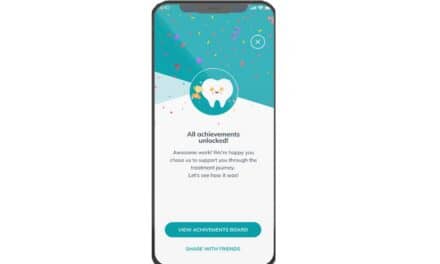As the COVID-19 crisis disrupts business as usual in orthodontic practices across the country, orthodontists are turning to these tools to maintain patient connection and keep treatment on track
By Tonya Johnson
Remote monitoring and virtual consults have taken on new importance as orthodontic practices struggle to provide continuity of care and engage new patients amid COVID-19. Looking ahead to the possibility of continued social-distancing and additional stay-at-home orders, tools like Dental Monitoring, SmileSnap, GP Ortho Tracking, and Align Technology’s new Smile Consult and Invisalign Virtual Care will likely provide some peace of mind for both practices and patients.
As practices closed down in March, Orthodontic Products asked its readers in an online survey if they were using a teledentistry platform to manage patients during the pandemic. Only 24% of respondents had the technology in place; however, more than a quarter put a teledentistry product on their wish list.
Ahead of the Curve
Alexander Waldman, DMD, MMSc, of Waldman Orthodontics in Beverly Hills, Calif, is ahead of the curve. He integrated the remote monitoring platform Dental Monitoring 2 years ago. The system provides full treatment management. Through notification alerts to the orthodontist’s online dashboard and communication center, Dental Monitoring, using artificial intelligence (AI), transforms the patient’s smart phone into a remote intraoral scanning device to process photo images of the teeth, allowing the doctor to keep track of both aligner and bracket treatment. It also helps monitor gum recession, occlusion, broken appliances, and even a patient’s hygiene—a big factor for teens, or rather any patient, when they can’t come into the office. Prior to COVID-19, half of Waldman’s patients were using the Dental Monitoring app—meaning continuity of care continued for those patients as if nothing happened.
As Michael Holmes, director of sales at Dental Monitoring North America, puts it, this is a “talk-in-your-pocket type platform” that allows doctors to be wherever their patients are.
“The current global crisis is going to eventually pass. However, our practices may not be back to business as usual…,” says Waldman. “Dental Monitoring allows us to increase our virtual presence, improve practice efficiency, reduce staffing, and also change our mindset so we are prepared for any potential future crises.”
In December, Waldman started using SmileSnap, a dental virtual consultation and visit tool. SmileSnap is integrated into the practice’s website and allows patients to send photos to initiate a new patient exam before they step foot in the office. The practice can then communicate with the potential patient via email or two-way text messaging, allowing the doctor to provide an assessment and staff to schedule an in-office visit.
“Orthodontists who have embraced remote monitoring [and virtual consults] are essentially conducting business as usual despite the widespread shutdowns. When we are physically back up and running, we’ll have already built that relationship with [patients] when they are able to come back in and are ready to get started with their treatment,” Waldman says.
Non-AI Options
To address doctors’ needs during this crisis, Dental Monitoring rolled out a “light” version of its app early. Photo Monitoring Light allows for at-home monitoring, with instant two-way communication, without the use of AI. While photo scans cost $3 per patient per mouth, the company is offering doctors the opportunity to get started for no cost for the first 4 months of the COVID-19 crisis.
Also, in the non-AI category of remote monitoring tools is GP Ortho Tracking. Developed by Doug Moorehead, DDS, an Ohio-based general dentist, the platform is designed to reduce orthodontic appointments and increase patient convenience during orthodontic treatment. GP Ortho Tracking does not require the patient to download an app, and there is no portal for the doctor to sign-up for. Instead, says GP Ortho Tracking General Manager Philip Michael, patients are provided with a direct link via email. Patients upload their photos via their smart phone, tablet, or computer, and send them to the doctor’s inbox. With the current crisis, GP Ortho Tracking launched emergency consult forms which allow orthodontists to screen patients to determine if an emergency appointment is warranted. The platform can also be used for new patient consults.
“What we’re trying to do is be responsible and inject that virtual step to make sure patients aren’t coming in unnecessarily—especially in the midst of all this,” says Michael. “The more we can virtualize and put online systems in place, we’re going to be able to take these innovations beyond just this outbreak. We’re going to continue to do orthodontic tracking online. We’re going to continue bringing in new patients in ways that they feel are most convenient to them—which a lot of times means virtually.”
For the Invisalign User
When the COVID-19 crisis hit, Align Technology’s Smile Consult and Invisalign Virtual Care tools were in early phases of pilot testing. Recognizing that doctors needed remote care tools immediately to help them stay connected to patients and keep treatment progressing during the crisis, Align rolled out Smile Consult and Invisalign Virtual Care early to its Invisalign users.
“We’re devoted to helping doctors and their practices through this difficult time,” said Simon Beard, senior vice president and general manager for the Americas at Align Technology. “Smile Consult and Invisalign Virtual Care provide an alternate way for doctors to continue supporting their patients in this time of social distancing. It also provides doctors with a convenient and efficient way to interact with their patients in the future after this pandemic comes to an end.”
With Smile Consult, practices can set-up a virtual face-to-face appointment with patients, allowing the doctor to track a patient’s treatment progress, discuss patient concerns remotely, and help answer questions before bringing a prospective patient in for an exam. Meanwhile, Invisalign Virtual Care works through the Invisalign Doctor Site (IDS) and My Invisalign app to connect doctors and patients virtually. For remote monitoring, patients take progress photos and videos on their smart phones that are uploaded to the doctor’s new Virtual Care tab in the IDS. The Virtual Care tab includes tools and features to monitor treatment progress and allows for two-way communications. Invisalign Virtual Care also allows for virtual appointments. Doctors can schedule these appointments with their Invisalign patients via the Zoom Cloud Meetings app. These face-to-face conversations are conducted in a HIPAA-compliant virtual environment.
Smile Consult and Invisalign Virtual Care are available at no charge to Invisalign certified doctors. Invisalign Virtual Care is being introduced on a rolling basis to allow Align to scale for effective training and for real-time refinement of the technology based on doctor feedback and suggestions.
Whatever tool orthodontists opt for, remote monitoring and virtual consults are likely to remain a key tool throughout this crisis and beyond. OP
Tonya Johnson is the associate editor at Orthodontic Products.










